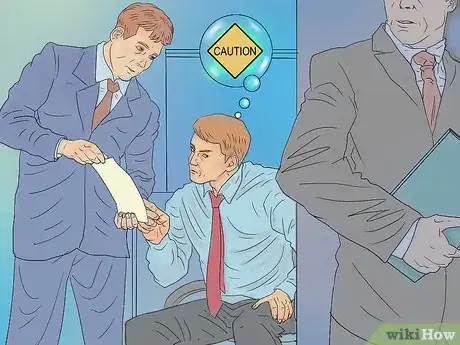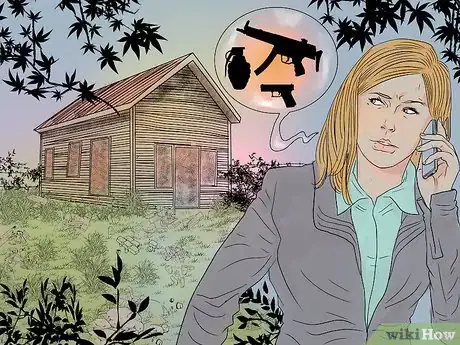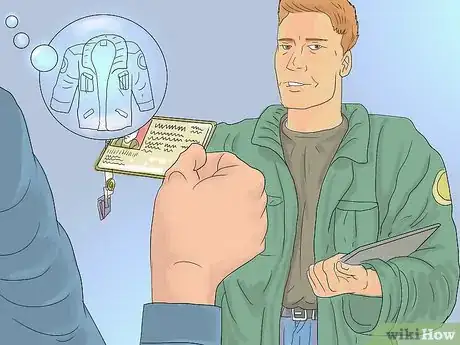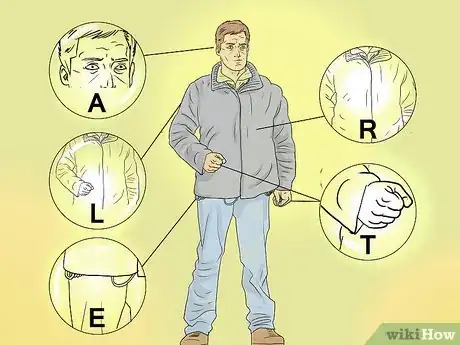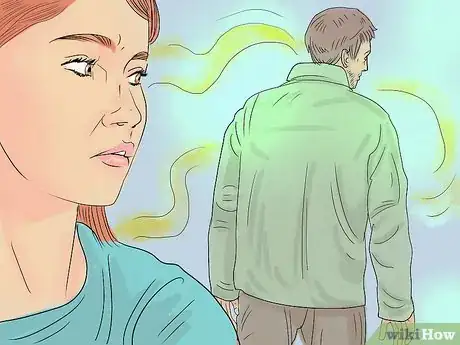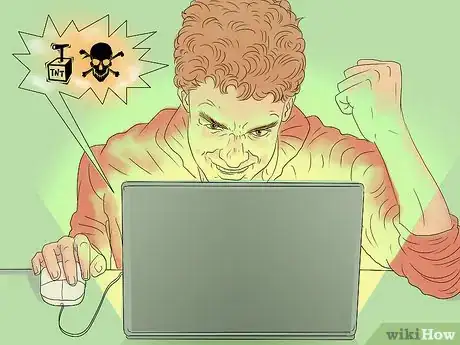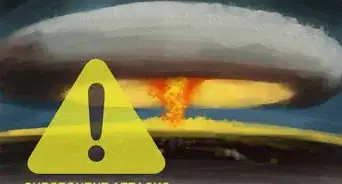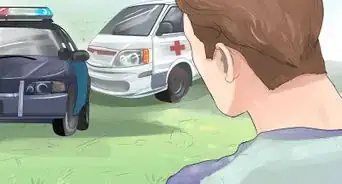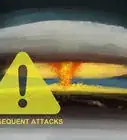X
This article was co-authored by wikiHow Staff. Our trained team of editors and researchers validate articles for accuracy and comprehensiveness. wikiHow's Content Management Team carefully monitors the work from our editorial staff to ensure that each article is backed by trusted research and meets our high quality standards.
This article has been viewed 85,870 times.
Learn more...
Keep your eyes out for signs of potential plots from terrorist groups, and keep your ears open to threats of lone-wolf violence within your community. If you notice any signs of terrorist activity, call emergency services, fill out this form [1], or contact your local police department.
Steps
Method 1
Method 1 of 3:
Recognizing Signs of Potential Plots
-
1Be alert to covert surveillance. Terrorists gather information about a potential target when planning an attack. Acts such as monitoring or recording a security apparatus should raise a red flag. If you notice someone who is not involved with a building using the camera on their phone, a camera, or binoculars, be alert. If you see that someone has been drawing diagrams, blueprints or detailed maps, be suspicious.[1]
- If someone is trying to hide what they are doing, be especially suspicious. While there are many reasons a person might be taking a picture, drawing a floor plan, or using binoculars, there are few good reasons for a person to attempt to hide such activities. Unauthorised or staff not related to maintenance work trying to gain access to such plans and diagrams
- Notice when someone is taking pictures of mundane objects, such as entrances, exits, or security cameras.
- Report security tests. If you notice someone leaving a bag, then coming back to check on it (or surveying it from a distance), they might be running a check on the security operations of a place.[2]
-
2Resist and report elicitation. Elicitation is the use of ordinary communications methods in order to gain sensitive information. If you have any information about military operations, capabilities, security procedures, or vulnerabilities, report anyone who tries to engage you in conversation on any of those points. If you find yourself speaking of anything sensitive, beware of eavesdroppers.[3]
- Any questions about security should be reported. Information about campus safety, mall guards, or transport police could all be exploited.
Advertisement -
3Notice stockpiling. If you notice someone you know, or someone who comes into a store you frequent, is purchasing (or stealing) explosives, weapons, ammunition, or bomb-making materials, you may be witnessing a potential terrorist. Bomb-making supplies can be as quotidian as fertilizer or beauty supplies.[4]
- Purchasing small amounts of anything not immediately lethal is not in itself a sign of stockpiling. Stockpiling happens when large quantities are accrued.
- Notice unusual forms of payment. If someone is buying supplies with a prepaid card that holds a large amount of money, they may have gotten that card from a larger terrorist organization.
- Recognize a stockpile. If you come across a store of goods such as weapons, chemicals or fertilizer hidden in an unusual place, such as a field or an abandoned building, report it.
Advertisement
Method 2
Method 2 of 3:
Profiling Potential Terrorists
-
1Keep an eye out for strangers who seem nervous and out of place. In an ordinary situation, someone who is sweating, looking around anxiously, or otherwise acting panicked may have violent intent. Be especially suspicious of anyone who seems out of place, is wearing a uniform that does not match or otherwise isn't quite right, or who doesn't seem to know anyone in a social space.[5]
- Be suspicious of anyone attempting to purchase military or police uniforms, decals, flight manuals, passes or badges, as these may be used to access secure locations.
-
2Recognize impersonators. Aside from people who seem out of place, look out for people soliciting donations for charities you don't recognize, workers in incomplete uniforms or uniforms that don't fit, or anyone presenting false or incomplete documents. Report it if someone tries to access a building, perhaps where you work, if they cannot prove they are authorized to enter.[6]
-
3Recognize the attire and posture of a suicide bomber. An imminent suicide bomber might exhibit signs the US government refers to as ALERT.[7]
- A – Alone and nervous. Report someone who is alone and seems nervous, sweating, eyes darting around, muttering.
- L – Loose and bulky clothing not compatible with weather conditions. If you see someone strangely overdressed, or who looks like they have something hidden under their clothes, report them.
- E – Exposed wires. Wires sticking out of clothing could indicate a bomb.
- R – Rigid mid-section. Wearing an explosives belt or harness makes some terrorists sit very upright. If you see someone with unnatural posture who exhibits other signs of ALERT, alert the authorities.
- T – Tightened hands. Someone with tightened hands may be holding a detonation device in place. Report someone in this posture immediately.
-
4Notice chemical odor or burns. People missing fingers, or who smell like chemicals, may be experimenting with explosives. Notice if someone is making frequent trips to remote places and returning with chemical burns or chemical odor.[8]
- Three common chemical odor smells are a sweet burning smell, an acrid smell (like bleach), or a motor-oil smell.[9]
Advertisement
Method 3
Method 3 of 3:
Watching Out for Lone Wolves
-
1Notice people who feel personally damaged by unrelated political developments. If you hear a friend, family member, or acquaintance complain that they have been personally wronged by political events that are remote, listen carefully. 80 percent of future lone wolves are known to take politics personally, and claim that they have been wronged enough that violence would be justified.[10]
- An example of an irrational claim would be: "Because we have a black president, a white man can't get a job in this country."
- This is not to be confused with someone who has been directly affected by a law and is rationally disappointed. For instance, a small business owner who has experienced a tax increase might say "I'm angry that our senator did not fight harder to protect my ability to compete with the big box stores." So long as this complaint is not followed by a threat, there is no sign of terrorist intent in this statement.
-
2Recognize when a lone wolf is broadcasting their intent. Report any messages on social media, any personal messages, and anything that is said to you that suggests an individual is contemplating violence. This can include suicide threats as well as threats against others. Watch out for anyone espousing the belief that violence is rational or necessary.[11]
- It is extremely common for a lone wolf to make public announcements when an attack is imminent.
- Combinations of political and personal complaints that are followed by veiled threats should be reported immediately.
- An example would be: "My girlfriend left me because women these days are too free. They think they can just get an abortion or a divorce whenever they want! I think somebody needs to send a strong message and really put them all back in their place."
-
3Listen for people who claim affinity with extremist groups. Many lone wolves speak admiringly of white supremacist groups, anti-abortion groups, foreign terrorist groups, or southern segregationist groups.[12]
-
4Don't look away from a stockpile of weapons. If you know someone in your community has an illegal store of weaponry, report them. If someone you know has assault rifles and other weapons built to kill large groups of people, even if they came by all those weapons legally, keep an eye on them or file a report.[13]
- Any signs of someone building or assembling explosives should be reported.
-
5Profile. Most lone wolf terrorists are single, unemployed white males with a criminal record. Signs of mental illness are also common, as is isolation from society. Not every lone wolf fits this profile: go on behavior before you go on these traits. However, if you do choose to report a suspicious individual for stockpiling weapons or broadcasting intent, make sure to mention if they fit the profile of a lone wolf terrorist.[14]
Advertisement
Community Q&A
-
QuestionShould I be concerned about sounds of constant construction and heavy moving in my neighbor's apartment?
 Community AnswerNo. This is very common, especially with people who have some louder hobbies like woodworking or exercising. If you're that concerned, maybe take your neighbor a gift so you can get a better idea of who they are and what their place is like. While you're there, joke about the noise to see if they explain it.
Community AnswerNo. This is very common, especially with people who have some louder hobbies like woodworking or exercising. If you're that concerned, maybe take your neighbor a gift so you can get a better idea of who they are and what their place is like. While you're there, joke about the noise to see if they explain it. -
QuestionHow do I make a bomb to show them that being blown up actually sucks?
 Community AnswerDon't. That's very much illegal and may fall into the category of terrorism itself.
Community AnswerDon't. That's very much illegal and may fall into the category of terrorism itself. -
QuestionHow do I not be scared of terrorist attacks?
 Community AnswerMake sure you know the emergency procedures. Learn how to use fire escapes, how to extinguish fires and how to contact the emergency services. Being prepared is sometimes a good way to alleviate your fears.
Community AnswerMake sure you know the emergency procedures. Learn how to use fire escapes, how to extinguish fires and how to contact the emergency services. Being prepared is sometimes a good way to alleviate your fears.
Advertisement
Warnings
- Describe the physical identifiers of anyone you observed, as well as their vehicles. Write down license plate numbers.⧼thumbs_response⧽
- Report this information if you can: a brief description of the activity, date, time and location of the activity.⧼thumbs_response⧽
- Never approach a suspected criminal or terrorist on your own. Always alert the authorities.⧼thumbs_response⧽
- Alert the authorities by calling local police or emergency services.⧼thumbs_response⧽
- Report any information about where people involved in suspicious activities may have gone[15]⧼thumbs_response⧽
Advertisement
References
- ↑ http://www.justice.gov/sites/default/files/usao-hi/legacy/2011/05/13/terrorisminformation.pdf
- ↑ http://publicsafety.utah.gov/2015/11/16/recognizing-8-signs-of-terrorism/]
- ↑ http://www.justice.gov/sites/default/files/usao-hi/legacy/2011/05/13/terrorisminformation.pdf
- ↑ http://www.justice.gov/sites/default/files/usao-hi/legacy/2011/05/13/terrorisminformation.pdf
- ↑ http://www.justice.gov/sites/default/files/usao-hi/legacy/2011/05/13/terrorisminformation.pdf
- ↑ http://publicsafety.utah.gov/2015/11/16/recognizing-8-signs-of-terrorism
- ↑ http://www.justice.gov/sites/default/files/usao-hi/legacy/2011/05/13/terrorisminformation.pdf
- ↑ http://www.justice.gov/sites/default/files/usao-hi/legacy/2011/05/13/terrorisminformation.pdf
- ↑ https://info.publicintelligence.net/DHS-Explosives.pdf
- ↑ https://www.ncjrs.gov/pdffiles1/nij/grants/248691.pdf
- ↑ https://www.ncjrs.gov/pdffiles1/nij/grants/248691.pdf
- ↑ https://www.ncjrs.gov/pdffiles1/nij/grants/248691.pdf
- ↑ https://www.ncjrs.gov/pdffiles1/nij/grants/248691.pdf
- ↑ https://www.ncjrs.gov/pdffiles1/nij/grants/248691.pdf
- ↑ http://www.dhs.gov/how-do-i/report-suspicious-activity
About This Article
Advertisement

